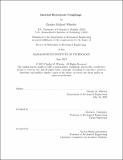Inertial Hysteresis Couplings
Author(s)
Wheeler, Charles Michael
DownloadThesis PDF (50.91Mb)
Advisor
Culpepper, Martin L.
Terms of use
Metadata
Show full item recordAbstract
This thesis presents the Inertial Hysteresis Coupling (IHC), a new family of variable-slip mechanical couplings/clutches aimed at achieving order-of-magnitude (∼10x) improvements in torque density (torque capacity / coupling diameter) over existing magnetic and fluid options. IHCs leverage combined normal, frictional, and inertial forces acting on sliding mechanical elements to realize this torque density improvement. The new design (a) allows for continuous modulation of these high-torque loads while (b) naturally achieving lockup at maximum engagement and (c) remaining well-suited to forced-convection cooling in high-heat-dissipation scenarios. Additionally, the base IHC design can be modified to achieve “one-way clutching” behavior while still retaining the ability to speed-synchronize (transmit load under partial slip) and achieve lockup. These characteristics make IHCs particularly well-suited to automotive and mobile robotics applications – for example, active control of vehicle differential slip – where high torque density and slip control are both of critical importance.
As the first investigation into IHCs, this research establishes multiple important foundations for analysis, simulation, and design. Starting from first principles, a ground-up model for IHC behavior is derived that encapsulates IHC geometry, relevant coordinate systems/transformations, kinematics, equilibrium equations, thermal loads, etc. Implemented in MATLAB, this model facilitates the selection of IHC parameters via performance projections, sensitivity studies, and a variety of different visualizations and animations. These tools enabled the design and fabrication of a physical IHC prototype, “ihcBENCH.” Through testing of this prototype, the key desired behaviors were successfully demonstrated: linear torque modulation via control of the “clutch angle” βo (max slip torque before lockup = 13.2 Nm, max/min slip torque ratio = 3.8, R² = 0.986); IHC lockup at high clutch engagement angles (βo ⪆ 37°); and the one-way clutching behaviors previously described.
Date issued
2023-06Department
Massachusetts Institute of Technology. Department of Mechanical EngineeringPublisher
Massachusetts Institute of Technology